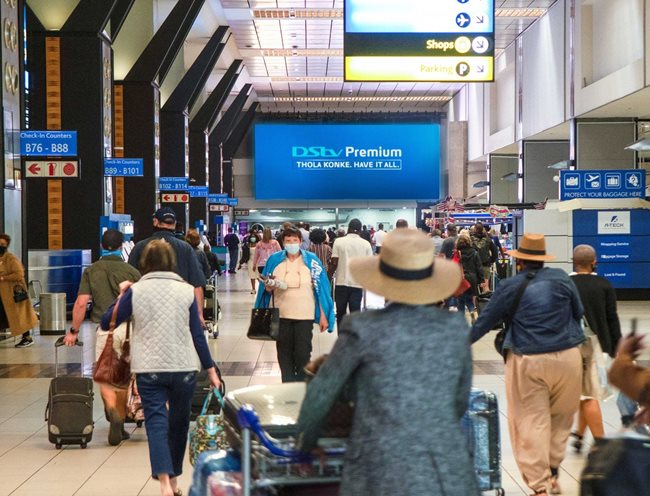Airport advertising returns to the limelight as air travel surges

It’s been a long, hard stretch for the airport industry, and all who depend on it.
Pre-pandemic, Airports Company South Africa (ACSA) recorded 248,519 aircraft landings at its airports during the 2019/20 financial year. This nose-dived to 86,434 during 2020/21. Naturally, this reflected a massive decline in the number of passengers travelling by plane; those who did were struck by the emptiness of formerly bustling airports.
Fortunately, this is changing fast: ACSA recently reported a renewed surge in air travel, with group CFO Siphamandla Mthethwa reported as saying the “worst is over”, following increasing numbers of passengers due to the government’s relaxing of local lockdown regulations.
Off the red list means busy airports
This, in conjunction with the ongoing rollout of vaccines and the UK’s removal of South Africa from their dreaded “red list”, all mean that the coming months herald a return to well-populated airports. The UK has particularly strong links with SA, and is the country’s biggest source of tourism outside Africa.
On average, more than 400,000 Brits visit each year – a figure that AP News reports dropped to less than 10,000 as Brits were discouraged from visiting SA, and required to undergo an expensive hotel quarantine on returning to the UK.
With South Africa off the red list as of 11 October, travel agencies report being inundated with enquiries and bookings – especially as the UK moves into autumn, and many look forward to escaping to sunnier climes over the festive season.
“The growth in passenger numbers will be fuelled by leisure travel, especially between now and January,” says Mzi Deliwe, deputy CEO of Provantage Media Group (PMG), which owns Airport Ads. “More than 300 000 British citizens have booked to come and spend Christmas in South Africa – and that’s only the UK. There will also be more business travel, given that a lot more people are vaccinated and feel safer to travel. Some business can’t be done via teams.”
As Deliwe notes, the surge is primarily driven by people travelling for leisure – both within the country and internationally. According to Brand Mapp 2021, 60% of high-income South Africans polled plan to take a domestic flight to their holiday destination in the next year (up 40%), and 29% plan to take an international flight for the same reason (up 17%). Around 48% plan to take a local city break, while 43% are set on a beach holiday.
“We are very excited to see domestic and international travel opening up, especially as we start to enter South Africa’s summer holiday season,” says LIFT co-founder and CEO, Jonathan Ayache. “Thanks to the lifting of Covid-19 restrictions domestically and the removal of South Africa from other international travel ban lists, things are looking up.”
And this should be an ongoing trend: In a recent webinar presented by IATA and Tourism Economics, the forecast for air passenger growth by region and scenario for 2020 – 2040 suggests that Africa and the Middle East show the greatest potential for growth over the next two decades, predicted to be between 8.6% and 10.5%.
Busy airports mean a renewed audience for advertising
All of which bodes a resumption of interest in airport advertising, long regarded as an especially effective medium, as it reaches an affluent and receptive audience in a captive setting.
While travelling by air, consumers pay much less attention to considerations such as need or price than usual. Moreover, brands seen at the airport are viewed as international and prestigious, increasing brand perception and driving sales.
As such, airport advertising has always scored highly on virtually every measure from reach to receptivity – and with Covid-19 protocols requiring earlier check-in, airport dwell times are now even longer, meaning greater exposure (and time to shop).
Add to this that the pandemic may have actually increased audience awareness of OOH advertising: An OAAA & Harris Poll conducted in April 2021 reported that “nearly half of Americans notice OOH advertising more than before the pandemic”, with heightened awareness and receptivity particularly prevalent among those aged 18 – 54.
Similarly, while 38% of South Africans who travelled by air recalled seeing an advertisement on OOH prior to lockdown, this figure jumped to 45% in the second half of 2020 (TGI SA 2020C).
All of which points to an excellent opportunity for would-be advertisers. Airport advertising specialist Airport Ads has been quick to alert the industry, reaching out to clients and agencies to share business cases, new developments, traffic movements, vaccination levels and predictions going forward.
“We’re encouraging our clients to buy now, as it’s much more affordable than 2019,” says Deliwe. “And, because airport rates are PAX-based, clients who sign a long-term deal now have the chance to secure their rate, even as passenger numbers increase – and so may get even greater value out of the deal in the long term.”
Deliwe believes that this – along with the resurgence of travel, a growing audience of leisure travellers, and the lure of digital media such as Airport TV and Visionet (a large format digital platform) – will attract new entrants to the market. Airport Ads has already seen a growing interest in airport advertising among sectors such as insurance and luxury clothing brands, for example.
The flight path ahead
Both Ayache and Deliwe are mindful that the pandemic is not yet over and waves are still a reality. Nevertheless, the resurgence of air travel augurs a return to brighter days and a resurgence of opportunity.
“The industry has undoubtedly experienced record lows during the pandemic, but we have also had sight of how resilient the sector is. Flexibility and the ability to adapt to the challenges is crucial,” says Ayache.





















